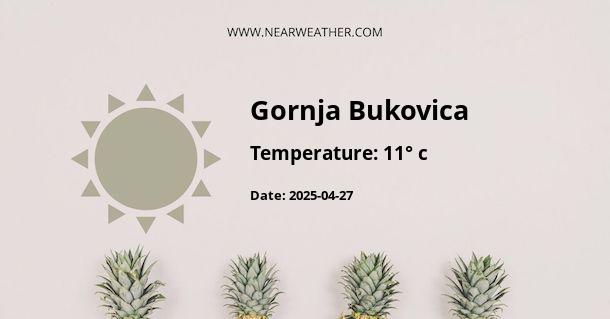Climate and Weather Overview of Gornja Bukovica, Republika Srpska
The climate of Gornja Bukovica, a settlement situated in the entity of Republika Srpska within Bosnia and Herzegovina, is characterized by a temperate continental climate. This generally means the region experiences four distinct seasons with relatively hot summers, cold winters, and transitional autumn and spring seasons. Understanding the weather and climatic patterns of Gornja Bukovica provides an insightful look into the environmental nuances that affect daily life, agriculture, tourism, and various other aspects of the region.
Seasonal Climate Variations
The seasonal climate variations of Gornja Bukovica are quite pronounced, with each season presenting its unique features:
Spring: The spring season in Gornja Bukovica typically begins in March and lasts until May. During spring, temperatures gradually increase from a chillier start towards a more mild and pleasant climate. This is a period of significant weather transitions, with a chance for late frosts in the early months and more rainfall as the season progresses.
Summer: Beginning in June and continuing through August, the summer months in Gornja Bukovica bring about warm to hot temperatures. The average daytime temperatures hover around the low to mid-20s°C (70s°F), though higher temperatures in the 30s°C (upper 80s or 90s°F) are not uncommon. This season tends to be the most stable regarding precipitation but can include intense thunderstorms.
Autumn: As autumn sets in from September to November, there is a notable cooling trend. The landscape transforms with vibrant colors, but weather patterns become more unpredictable. Temperature decreases are accompanied by increased precipitation, making for a damp and cooler environment as winter approaches.
Winter: December through February is characterized by cold, sometimes harsh winter weather conditions. Average temperatures can drop below freezing. Snowfall is common in Gornja Bukovica, which can lead to beautiful winter landscapes but also poses challenges such as icy roads and disruptions to daily life.
Temperature and Precipitation Patterns
Temperature and precipitation are two key factors that define the climate of Gornja Bukovica. Below is a breakdown of these patterns throughout the year.
- Temperatures: Average temperatures in Gornja Bukovica range from -2°C to 2°C (28°F to 36°F) in winter and from 18°C to 28°C (64°F to 82°F) in summer. Spring and autumn have moderate temperatures, usually between 8°C and 18°C (46°F to 64°F).
- Precipitation: The area receives a fairly even distribution of rainfall throughout the year, with an increase in spring and autumn. Average annual precipitation measures around 800-1000mm.
Monthly Climate Averages
The following table represents the typical monthly climate averages for Gornja Bukovica, combining both temperature and precipitation:
| Month | Average High (°C) | Average Low (°C) | Precipitation (mm) |
|---|---|---|---|
| January | 2 | -5 | 70 |
| February | 4 | -3 | 65 |
| March | 9 | 0 | 70 |
| April | 14 | 4 | 75 |
| May | 20 | 9 | 85 |
| June | 24 | 12 | 95 |
| July | 26 | 14 | 90 |
| August | 26 | 14 | 85 |
| September | 21 | 10 | 95 |
| October | 15 | 6 | 80 |
| November | 9 | 1 | 85 |
| December | 3 | -3 | 75 |
Wind Patterns and Climate Extremes
Gornja Bukovica experiences various wind patterns throughout the year which can influence the perceived temperature and weather conditions:
- Bora: A dry, cold wind descending from the mountains can lead to sudden drops in temperature and clear skies.
- Jugo: A south-eastern wind, often bringing humidity and precipitation, particularly along coastal regions, although its effects can be felt inland.
Extreme climate events, although less common, can include episodes of severe weather such as intense thunderstorms during the summer or extreme snowfall during winter months.
Climate Impacts on Local Life and Economy
The climate in Gornja Bukovica significantly impacts the local lifestyle and economy. Agriculture, which includes the cultivation of crops, fruits, and livestock rearing, is closely tied to the seasonal climate patterns. Furthermore, the weather can affect tourism, especially regarding outdoor recreational activities and cultural events which are often planned during the more stable and warmer months of the year.
Another important aspect to consider is the heating season. Due to cold winter temperatures, adequate home insulation and heating systems are essential for the inhabitants of Gornja Bukovica, which also reflects upon the local energy consumption and expenses.
Climate Change Considerations
Climate change is a global phenomenon, and Gornja Bukovica is not immune to the shifts that come with it. Increases in extreme weather events, shifts in precipitation patterns, and rising temperatures are potential future concerns that could impact agriculture, natural ecosystems, and the way of life in this region. It is critical to monitor these changes to adapt effectively and sustainably.
In conclusion, Gornja Bukovica's climate and weather are characterized by stark seasonal contrasts, moderated by geographical features, and marked by occasional extremities. Both residents and visitors alike need to be aware of the local weather patterns to plan accordingly for their daily activities, agricultural practices, and any other climate-dependent events and industries.
A - Gornja Bukovica's Latitude is 44.351940 & Longitude is 19.780830.
A - Weather in Gornja Bukovica is 14° today.
A - Climate Conditions in Gornja Bukovica shows overcast clouds today.
A - Humidity in Gornja Bukovica is 84% today.
A - Wind speed in Gornja Bukovica is 9.18 km/h, flowing at 325° wind direction. today.
